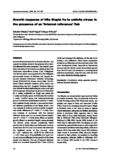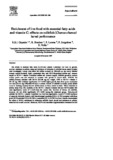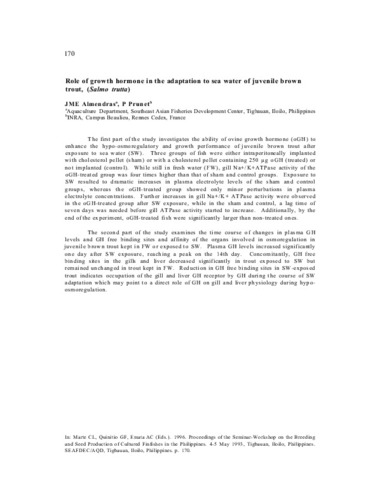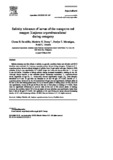Growth response of Nile tilapia fry to salinity stress in the presence of an ‘internal reference’ fish

Lihat/
Request this document
Tarikh
2005Page views
260Metadata
Lihat penerbitan penuhCited times in Scopus
Share
abstrak
Growth of three strains of Oreochromis niloticus L. fry exposed to salinity stress in the presence of an internal reference fish were compared. The Central Luzon State University (CLSU) strain was obtained from the Freshwater Aquaculture Center, CLSU, Philippines. The ISRAEL strain was acquired from the Philippine government's Bureau of Fisheries and Aquatic Resources National Freshwater Fisheries Technology Center (BFAR-NFFTC), Munoz, Nueva Ecija. The National Inland Fisheries Institute (NIFI) strain was obtained from the NIFI, Bangkok, Thailand. Eight to nine full-sib families (replicates) per strain were split into two groups. One group was grown in freshwater for 2 weeks, acclimated to 32 ppt and reared for 2 weeks and finally grown in freshwater for another 2 weeks. Another group was contemporaneously grown in freshwater polyethylene tanks for 6 weeks. Each replicate family included a size-matched internal reference population of red tilapia strain. Two-way analysis of variance (anova) revealed no significant strain differences (P=0.081; r2=0.106). However, analysis of covariance with the internal reference strain used as a covariate showed significant (P=0.049; r2=0.638) strain effects on specific growth (based on standard length measurements). The ISRAEL strain showed consistently better growth rate in both saline and freshwater environments than the NIFI and CLSU strains. We estimated the statistical power of the two-way anova (ϕ=√(k′−1)(factor MS−s2)/(k′s>2); Zar 1984) to be ∼0.30. There was a 70% probability of a Type II error and no true difference in the growth of the three strains was detected. The use of internal reference strain as a covariate improved the r2 from 0.106 to 0.638 and increased the efficiency of the test in detecting a true difference. Other strain comparison studies in our laboratory at the Southeast Asian Fisheries Development Center Aquaculture Department showed that the ISRAEL strain shows better growth than the NIFI and CLSU strains in a crowding stress tolerance experiment, when fed only with rice bran and under restrictive feeding regimes.
Suggested Citation
Basiao, Z. U., Eguia, R. V., & Doyle, R. W. (2005). Growth response of Nile tilapia fry to salinity stress in the presence of an ‘internal reference’ fish. Aquaculture Research , 36(7), 712-720. https://doi.org/10.1111/j.1365-2109.2005.01283.x
Subjek
stress  ; biometrics
; biometrics  ; brackishwater fishes
; brackishwater fishes  ; feed composition
; feed composition  ; feeding behaviour
; feeding behaviour  ; fish culture
; fish culture  ; fry
; fry  ; growth rate
; growth rate  ; inland fisheries
; inland fisheries  ; salinity effects; salinity tolerance
; salinity effects; salinity tolerance  ; stocking density
; stocking density  ; tolerance
; tolerance  ; genetics
; genetics  ; growth
; growth  ; salinity
; salinity  ; strain
; strain  ; Oreochromis niloticus
; Oreochromis niloticus  ; Israel
; Israel  ; Philippines, Luzon I., Nueva Ecija, Munoz; Thailand, Chacoengsao Prov., Bangkok; Internal reference
; Philippines, Luzon I., Nueva Ecija, Munoz; Thailand, Chacoengsao Prov., Bangkok; Internal reference
 ; biometrics
; biometrics  ; brackishwater fishes
; brackishwater fishes  ; feed composition
; feed composition  ; feeding behaviour
; feeding behaviour  ; fish culture
; fish culture  ; fry
; fry  ; growth rate
; growth rate  ; inland fisheries
; inland fisheries  ; salinity effects; salinity tolerance
; salinity effects; salinity tolerance  ; stocking density
; stocking density  ; tolerance
; tolerance  ; genetics
; genetics  ; growth
; growth  ; salinity
; salinity  ; strain
; strain  ; Oreochromis niloticus
; Oreochromis niloticus  ; Israel
; Israel  ; Philippines, Luzon I., Nueva Ecija, Munoz; Thailand, Chacoengsao Prov., Bangkok; Internal reference
; Philippines, Luzon I., Nueva Ecija, Munoz; Thailand, Chacoengsao Prov., Bangkok; Internal reference
Koleksi
- AQD Journal Articles [1240]
Related items
Showing items related by title, author, creator and subject.
-
Enrichment of live food with essential fatty acids and vitamin C: effects on milkfish (Chanos chanos) larval performance
Gapasin, R. S. J.; Bombeo, R.; Lavens, P.; Sorgeloos, P.; Nelis, H. (Elsevier, 1998)The effects of essential fatty acids (EFA) and vitamin C-enriched live food on growth, survival, resistance to salinity stress and incidence of deformity in milkfish larvae reared in tanks were investigated. Larvae were ... -
Role of growth hormone in the adaptation to sea water of juveline brown trout, (Salmo trutta)
Almendras, J. M. E.; Punet, P. (Aquaculture Department, Southeast Asian Fisheries Development Center, 1996)The first part of the study investigates the ability of ovine growth hormone (oGH) to enhance the hypo-osmoregulatory and growth performance of juvenile brown trout after exposure to sea water (SW). Three groups of fish ... -
Salinity tolerance of larvae of the mangrove red snapper (Lutjanus argentimaculatus) during ontogeny
Estudillo, Chona B.; Duray, Marietta N.; Marasigan, Evelyn T.; Emata, Arnil C. (Elsevier, 2000)Salinity tolerance and the effects of salinity on growth, condition factor and chloride cell (CC) densities were evaluated for Lutjanus argentimaculatus larvae during ontogeny. Tolerance of L. argentimaculatus larvae to ...



